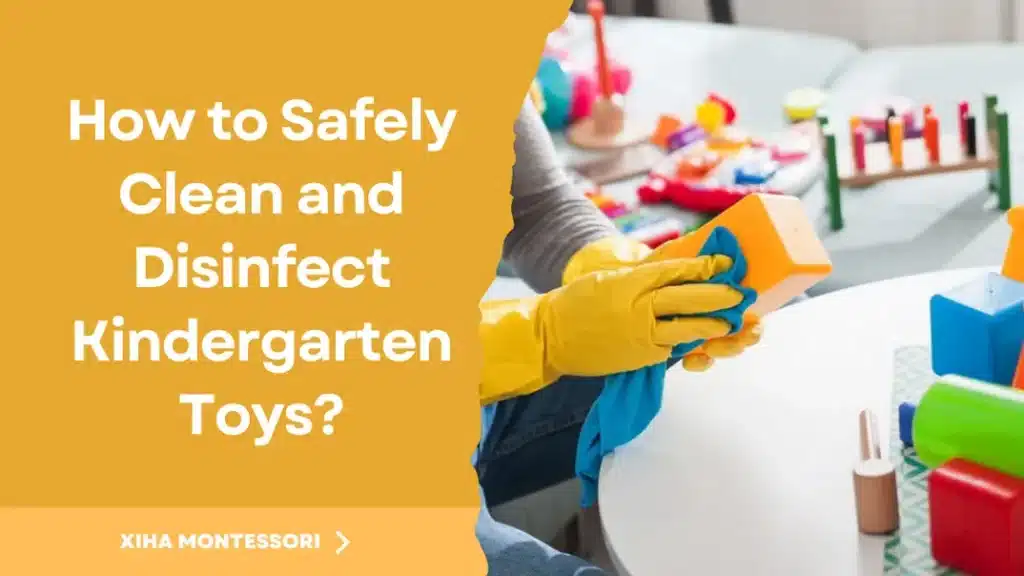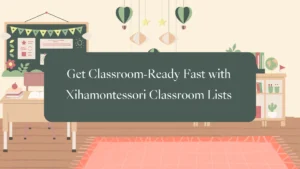Safely clean and disinfect kindergarten toys are essential to maintaining a healthy and germ-free environment for young children. Kindergarten toys are an important part of children’s daily learning and play. However, they can also be a breeding ground for germs if not cleaned properly. Little ones are constantly exposed to various toys, making them potential hotspots for germs and bacteria.
The safest way to clean and disinfect kindergarten toys involves a combination of proper cleaning techniques and the use of child-safe disinfectants. Regular cleaning with mild soap and water, followed by disinfecting with products approved for use around children, is essential. Additionally, ensuring the toys are thoroughly rinsed and dried prevents any residue from harming the children.
Children often share toys and may put them in their mouths, which increases the risk of spreading infections. Whether you are a teacher, parent, or caregiver, this article will teach you how to clean and disinfect kindergarten toys properly.
The Importance of Clean and Disinfect Kindergarten Toys
Toys in a kindergarten setting are constantly being touched, shared, and put in mouths, making them a prime breeding ground for germs and bacteria. These harmful microorganisms can lead to the spread of illnesses and infections, putting the well-being of the children at risk.
Regular cleaning and disinfection of toys helps eliminate these harmful pathogens, reducing the chances of children contracting illnesses such as the common cold, flu, and gastrointestinal infections. It also helps to create a more hygienic play area where children can engage in learning and exploration without the risk of exposure to potentially dangerous germs.
Moreover, maintaining a clean and disinfected toy environment promotes overall cleanliness and good hygiene habits in children. By witnessing the importance placed on toy cleanliness, children are more likely to understand the significance of hand washing, surface cleaning, and other hygienic practices. This can have a lasting impact on their health, both in the present and as they grow older.
A Step-by-Step Guide to Clean and Disinfect Kindergarten Toys
Effectively cleaning and disinfecting kindergarten toys requires a multi-step approach to ensure the complete removal of germs and bacteria. Here are the recommended steps for properly cleaning and disinfecting toys:
- Categorize and Inspection Toys: The toys are sorted based on material and condition. Separate any toys that are damaged, broken, or have small parts that could pose a choking hazard.
- Read Toy Instructions: Always check the manufacturer’s cleaning and care instructions before proceeding. Some toys may have specific guidelines for cleaning and disinfecting that need to be followed.
- Pre-cleaning: Use a mild soap or detergent solution and a soft-bristled brush to remove any visible dirt, grime, or debris from the surface of the toys. This helps to prepare the toys for the disinfection process.
- Wash: Use warm, soapy water to clean the toys. For fabric toys, use the washing machine if safe.
- Scrub and Rinse: Rinse off all soap residue, as the remaining soap can neutralize disinfectants.
- Disinfection: Apply an appropriate disinfectant according to the toy material. Ensure you cover all surfaces.
- Drying and Storage: Air-dry the toys or use a clean, lint-free cloth to wipe them down. Ensure the toys are completely dry before returning them to the play area.
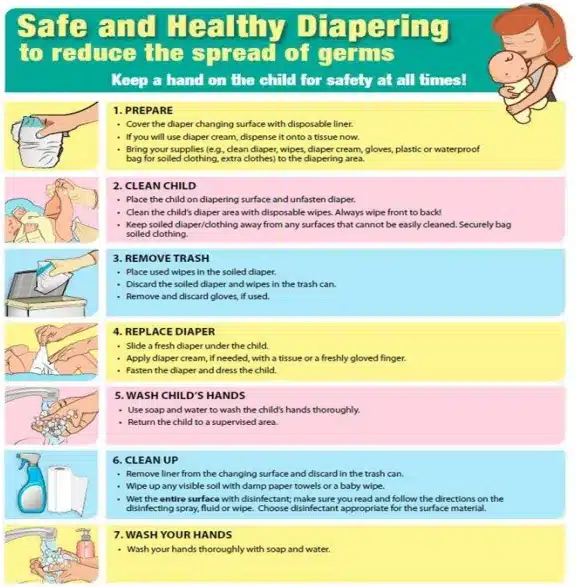
Cleaning and Disinfecting Toys Made of Different Materials
Not all toys use the same cleaning and disinfecting methods, depending on the type of toy. Below, we’ll cover the best way to clean every toy.
Cleaning and Disinfecting Plastic Toys
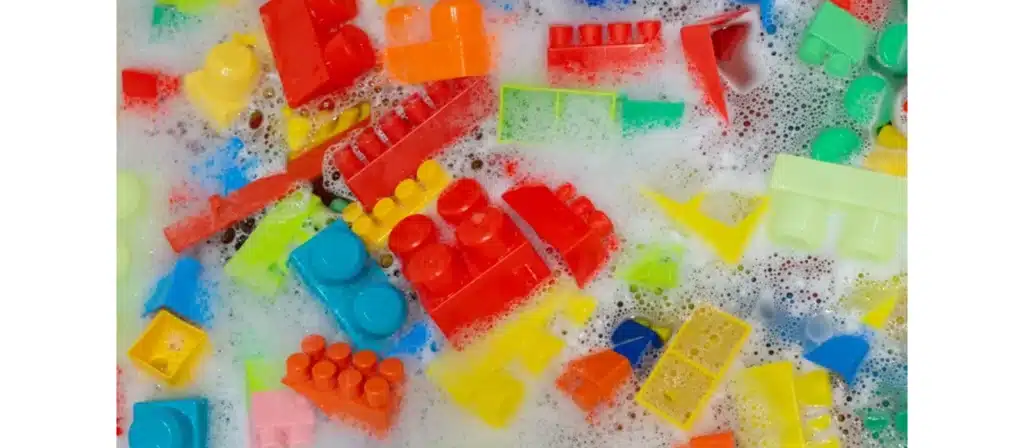
Cleaning Methods for Plastic Toys
Plastic toys are simple to clean. Mix mild dish soap with warm water to wash them. Scrub with a brush to remove dirt, then rinse well so no soap stays on them.
Disinfecting Plastic Toys
For plastic toys, use a bleach solution to disinfect them. Mix half a cup of bleach with one gallon of water, soak toys for five minutes, rinse, then air dry them completely after the soaking process ends.
Cleaning and Disinfecting Wooden Toys
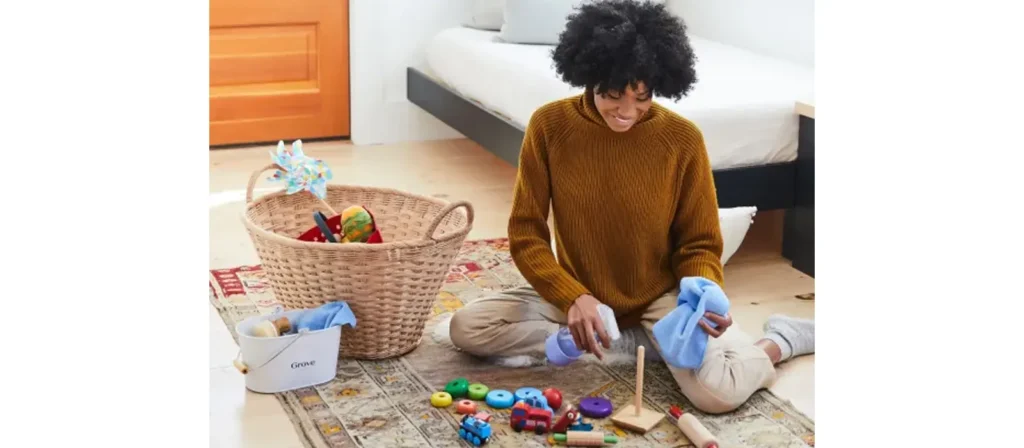
Cleaning Methods for Wooden Toys
Wooden toys need gentle care to stay nice. Mix vinegar and water equally in a bowl. Dip a cloth in it, then wipe the wood gently. This cleans dirt without hurting the toy. Don’t soak wooden toys to avoid damage.
Disinfecting Wooden Toys
To disinfect wooden toys, use a safe spray. Lightly mist the toys evenly with it. Let them dry completely in the air. This kills germs but keeps the wood safe.
Cleaning and Disinfecting Non-washable Plush Toys
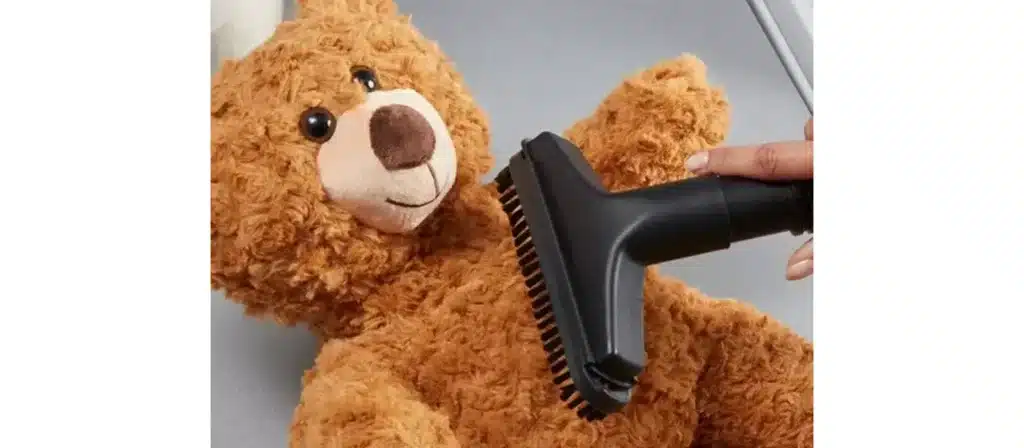
Cleaning Methods for Non-washable Plush Toys
Non-washable plush toys need special care. Use a vacuum with a brush to clean dust. Sprinkle baking soda on the toy for smells. Leave it for 15 minutes, then vacuum again. This keeps the toy fresh without using water.
Disinfecting Non-washable Plush Toys
To disinfect non-washable plush toys, use a safe spray. Lightly spray the toy and let it dry in the air. Make sure the spray is safe for kids. Regular cleaning stops germs and keeps play areas healthy.
Cleaning and Disinfecting Washable Plush Toys
Cleaning Methods for Washable Plush Toys
Washable plush toys can be machine-washed. Use a gentle cycle with mild soap. Put the toy in a mesh bag to protect it. Air dry or use low heat to avoid damage.
Disinfecting Washable Plush Toys
After washing, spray washable plush toys with safe disinfectant. Lightly mist to cover all parts well. Let them dry fully before playtime again. This step adds extra germ protection.
Cleaning and Disinfecting Bath Toys
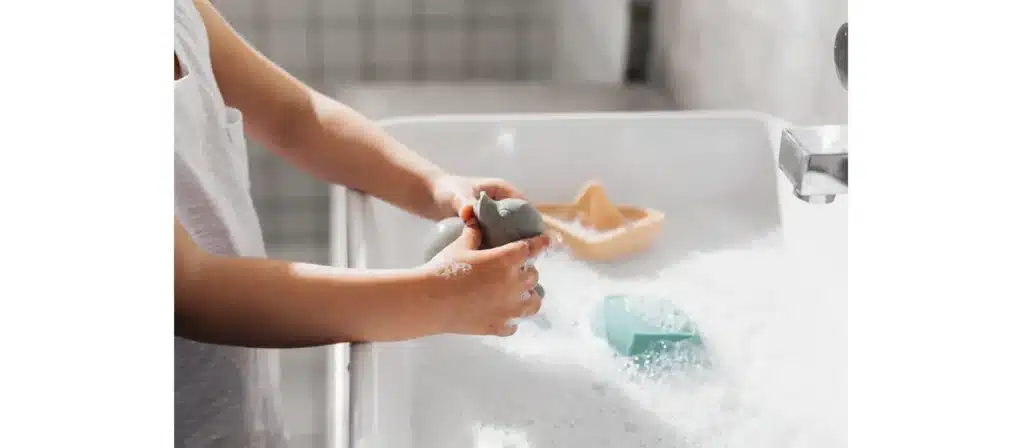
Cleaning Methods for Bath Toys
Bath toys get soap scum and mildew often. Use warm water with mild soap to clean them well. Fill a basin with soapy water, put toys in, scrub grime off with a brush, then rinse all soap away.
Disinfecting Bath Toys
Disinfect bath toys using the bleach solution. Mix half a cup of bleach with one gallon of water, soak toys for five minutes, rinse well to remove bleach, and then air dry them fully.
Cleaning and Disinfecting Electronic Toys
Cleaning Methods for Electronic Toys
Electronic toys need special care when cleaning. Use a damp cloth with a little mild soap on surfaces only. Avoid getting water inside parts; wipe gently to clean dust or prints; dry cloth removes moisture left.
Disinfecting Electronic Toys
For electronic toy disinfection, be careful. Use wipes made for electronics; wipe surface gently avoiding buttons or openings; let air dry before next use.
Cleaning and Disinfecting Silicone Toys
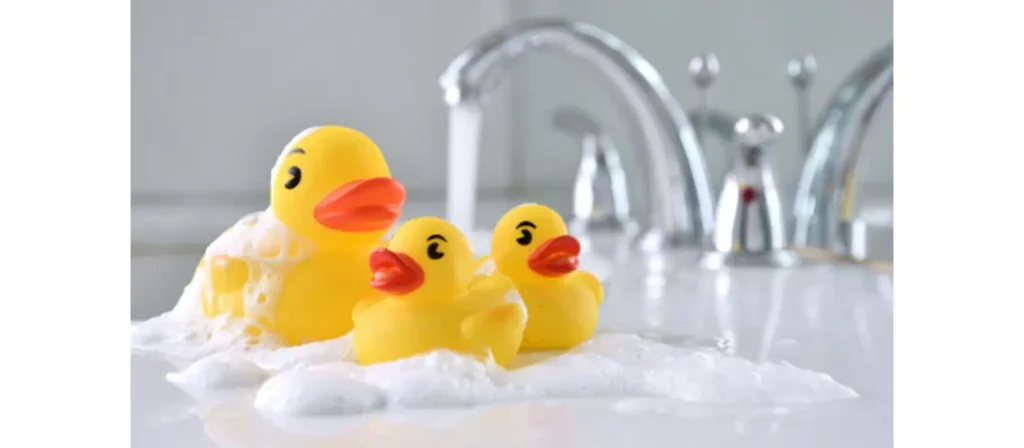
Cleaning Methods for Silicone Toys
Silicone toys need careful cleaning. Use warm water with mild soap. A soft brush helps clean dirt. Rinse well to remove soap. Air dry so no water stays, stopping mold.
Disinfecting Silicone Toys
Disinfect silicone toys safely. Hydrogen peroxide works well. Spray lightly and wait a few minutes. Rinse again to clear the disinfectant. Let them air dry before use.
Cleaning and Disinfecting Outdoor Toys
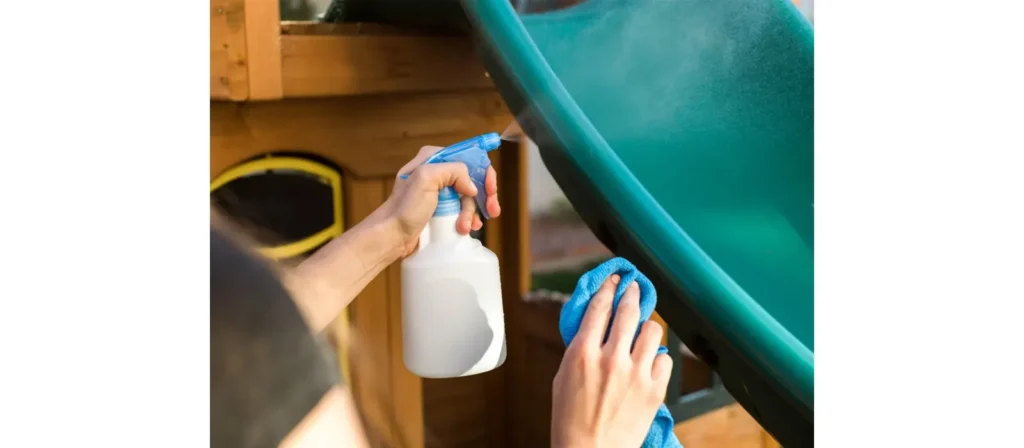
Cleaning Methods for Outdoor Toys
Outdoor toys get dirty often. Warm water with baking soda cleans them well. Scrub tough spots with a brush. Rinse with a hose to clear the soap away. Sun drying stops moisture from staying.
Disinfecting Outdoor Toys
Outdoor toys need regular disinfection. Bleach solution kills germs well. Mix half a cup of bleach in one gallon of water. Soak toys for five minutes, then rinse off the bleach fully. Dry in the sun for extra cleanliness.
What is the Difference Between Cleaning and Disinfecting?
Cleaning and disinfecting are two distinct processes that are both crucial for maintaining a healthy environment, but they serve different purposes:
- Cleaning:
- Purpose: Removes dirt, grime, and impurities from surfaces. Cleaning does not necessarily kill germs but reduces their number by removing them physically from the surface.
- Method: Typically involves soap (or detergent) and water to remove dirt physically and germs from surfaces. This process does not necessarily kill germs but reduces their numbers and the risk of spreading infection by removing them.
- Frequency: Regular cleaning is recommended as part of routine maintenance for homes, workplaces, and public areas.
- Disinfecting:
- Purpose: Kills germs on surfaces or objects. Disinfecting works by using chemicals to kill germs, not just removing them. This process does not necessarily clean dirty surfaces but can further lower the risk of spreading infection.
- Method: Involves the use of chemicals known as disinfectants that are specifically designed to kill germs. Common disinfectants include bleach, alcohol solutions with at least 70% alcohol, and other EPA-registered disinfectants.
- Frequency: Disinfecting is usually recommended in areas where germs are more likely to spread, like bathrooms, kitchens, or areas that frequently come into contact with bodily fluids. It’s particularly important to disinfect during outbreaks of illnesses.
Key Differences:
- Cleaning removes germs, dirt, and impurities from surfaces using soap and water, making surfaces visually clean and lowering the number of germs.
- Disinfecting kills the germs on surfaces or objects using chemicals, reducing the risk of infection but not necessarily cleaning the surface.
Important Considerations for Clean and Disinfect Kindergarten Toys
When cleaning and disinfecting kindergarten toys, it’s crucial to take proper safety precautions to protect the children and the staff involved. Here are some important safety considerations:
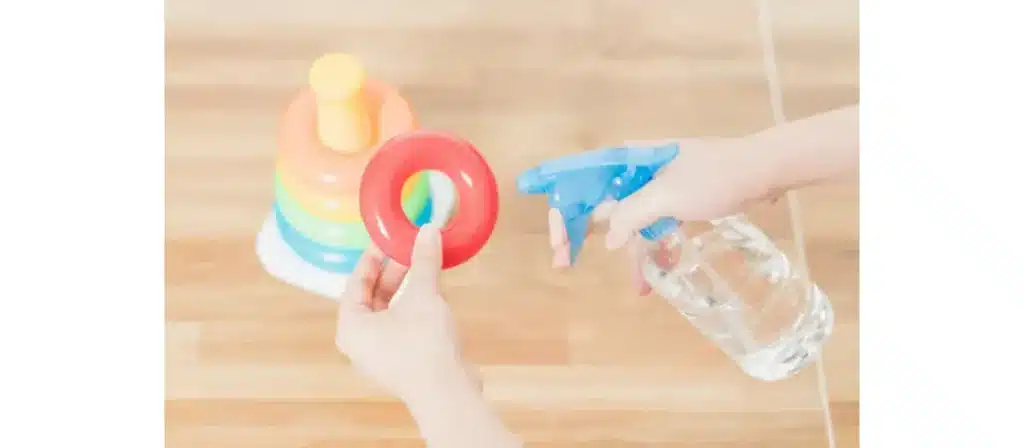
- Use Appropriate Personal Protective Equipment (PPE): Wear gloves, masks, and eye protection when handling cleaning and disinfecting products to minimize the risk of exposure.
- Ensure Proper Ventilation: Work in a well-ventilated area or open windows to allow for adequate air circulation, especially when using strong disinfectants.
- Follow Manufacturer Instructions: Carefully read and follow the instructions on the labels of cleaning and disinfecting products, paying attention to recommended dilution rates, contact times, and any safety warnings.
- Avoid Mixing Chemicals: Never mix different cleaning or disinfecting products, as this can create dangerous fumes or reactions.
- Store Products Safely: Keep all cleaning and disinfecting products out of reach of children and in a secure, locked cabinet or storage area.
- Rinse Thoroughly: Ensure all toys are rinsed thoroughly with clean water to remove any residual cleaning or disinfecting agents before returning them to the play area.
- Dispose of Waste Properly: Properly dispose of any cleaning materials, such as used gloves or paper towels, to prevent the spread of germs and contaminants.
- Train Staff on Safety Protocols: Provide comprehensive training to all staff members on properly handling and using cleaning and disinfecting products and the importance of following safety guidelines.
How Often Should I Clean and Disinfect Kindergarten Toys?
The frequency of cleaning and disinfecting kindergarten toys can vary depending on several factors, such as the type of toys, the number of children using them, and the level of activity in the play area. However, as a general guideline, it’s recommended to clean and disinfect toys regularly, typically following these schedules:
- Daily Cleaning: Toys used frequently throughout the day, such as those in the “free play” or “circle time” areas, should be cleaned and disinfected daily. This includes wiping down surfaces, removing visible dirt and grime, and disinfecting the toys.
- Weekly Cleaning: Toys used less frequently, such as those in the “quiet play” or “reading” areas, should be cleaned and disinfected at least once weekly. This more thorough cleaning can involve submerging the toys in disinfectant or using a dishwasher for hard, plastic toys.
- Monthly Deep Cleaning: Conduct a more extensive deep cleaning of all toys in the kindergarten every month. This may involve dismantling toys, washing soft items in the washing machine, and thoroughly disinfecting all surfaces.
Additionally, it’s important to clean and disinfect toys immediately after they have been used by a child who is sick or showing symptoms of illness. This helps to prevent the spread of germs and reduce the risk of cross-contamination.
Establishing a consistent cleaning and disinfection schedule and monitoring the condition of the toys can help maintain a safe and hygienic play environment for the children in the kindergarten.
Tips for Maintaining Cleanliness and Hygiene in the Kindergarten Toy Area
Keeping the kindergarten toy area clean and hygienic requires a multi-faceted approach beyond cleaning and disinfecting the toys. Here are some tips to help maintain cleanliness and hygiene in the toy area:
- Implement a Toy Rotation System: Regularly rotate the toys available in the play area, allowing for more thorough cleaning and disinfection of the currently unused toys.
- Encourage Hand-washing: Ensure children wash their hands thoroughly with soap and water before and after playing with the toys. This helps reduce the germs transferred from their hands to the toys.
- Provide Hand Sanitizer: Make alcohol-based hand sanitizer readily available in the toy area, encouraging children and staff to use it when hand-washing is impossible.
- Establish a Cleaning Schedule: Develop a cleaning schedule that outlines the frequency and responsibilities for cleaning the toy area, including surfaces, storage containers, and any other equipment.
- Train Staff on Proper Cleaning and Disinfection: Provide comprehensive training to all staff members on the correct techniques for cleaning and disinfecting toys and maintaining a clean and hygienic environment.
- Encourage Children to Keep Toys in Designated Areas: Teach children to keep toys in their designated play areas and to avoid bringing them to other parts of the kindergarten, which can help prevent the spread of germs.
- Regularly Inspect and Maintain the Toy Area: Regularly inspect the toy area for any signs of damage, wear, or contamination, and address any issues promptly to ensure the continued safety and cleanliness of the environment.
By implementing these tips, you can help to create a clean, hygienic, and safe play environment for the children in your kindergarten.
More Related Questions
How can I make homemade disinfectants for toys?
Making homemade disinfectants can be a safe and cost-effective solution. For example, a white vinegar and water mix works well for cleaning and disinfecting plastic toys. However, always ensure that homemade solutions are safe for use on the materials the toys are made from and are thoroughly rinsed off.
What should I do if a toy cannot be cleaned with water?
For toys that cannot be cleaned with water, like those made from wood or with electronic components, use a disinfectant wipe or a cloth sprayed with a non-toxic disinfectant. After wiping, ensure the toy is completely dry before returning it to use.
Are there any toys that should not be disinfected?
Toys made from natural materials, such as wooden blocks treated with natural oils, should not be disinfected with harsh chemicals. These toys should be wiped with a damp cloth and air dry. Over-disinfecting can damage their surface and reduce their lifespan.
How can I ensure toys are completely disinfected?
To ensure thorough disinfection, follow these steps: clean the toy with soap and water to remove dirt, rinse it well, apply a disinfectant, and let it sit for the recommended time before rinsing and drying. This ensures that the disinfectant has enough contact time to be effective.
What about cleaning plush toys or soft fabric toys?
Plush toys can often be machine-washed. Use a gentle cycle with mild detergent and air dry to prevent shrinking or damage. Spot cleaning with a fabric-safe disinfectant might be necessary for larger or more delicate fabric toys. Always check the care label on the toy before washing.
How should toys be stored after cleaning?
Proper storage is as important as cleaning. Once toys are clean and dry, store them in a clean, dry area to prevent recontamination. For soft toys, ensure they are fully dried to avoid mold growth. Rotating toys and cleaning storage areas regularly will help maintain a clean environment.
Conclusion
Keeping kindergarten toys clean and sanitized is crucial for the health and safety of children. By using the appropriate cleaning methods for each type of toy material, we can effectively minimize the risk of spreading germs and ensure a safe environment for all. Regular cleaning protects children and extends the toys’ life, making them a better investment for kindergartens.
Regularly cleaning and disinfecting kindergarten toys is important. Germs spread fast with shared toys. Cleaning stops germs from spreading. Parents and caregivers must clean toys often. Clean spaces keep kids safe and teach good habits. By cleaning toys, playtime becomes safer and more fun for all.

